Middle East and Africa Flexible Packaging Market Size
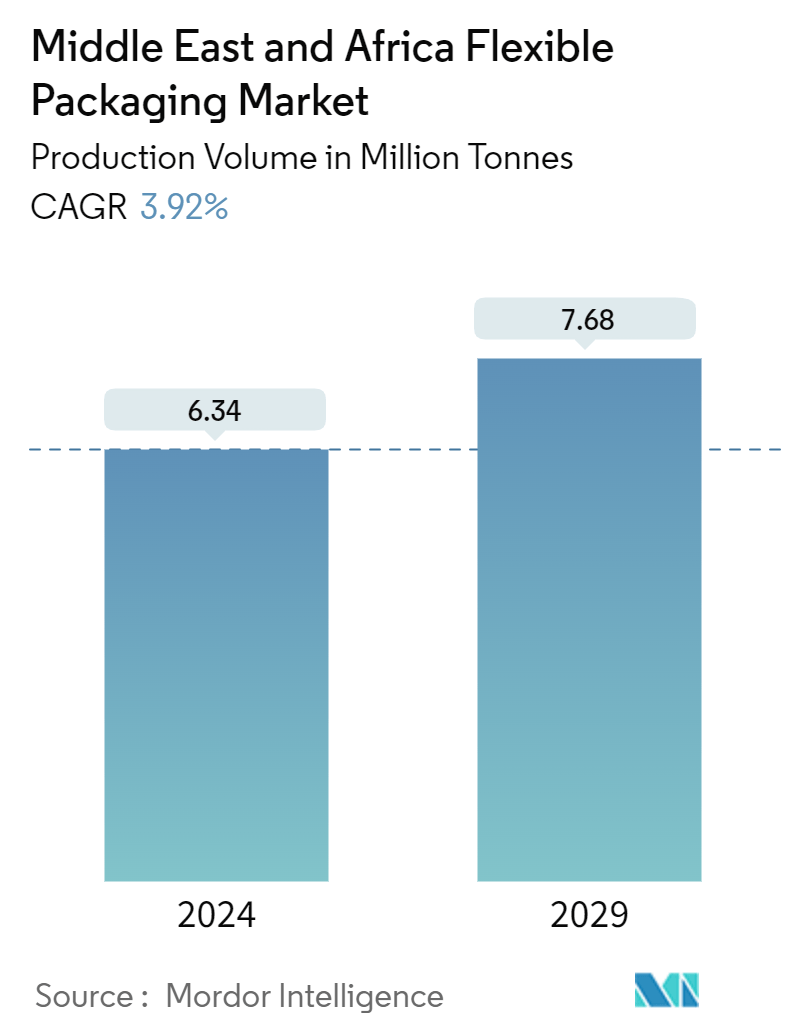
| Study Period | 2019 - 2029 |
| Base Year For Estimation | 2023 |
| Forecast Data Period | 2024 - 2029 |
| Historical Data Period | 2019 - 2022 |
| CAGR (2024 - 2029) | 3.92 % |
| Market Concentration | Low |
Major Players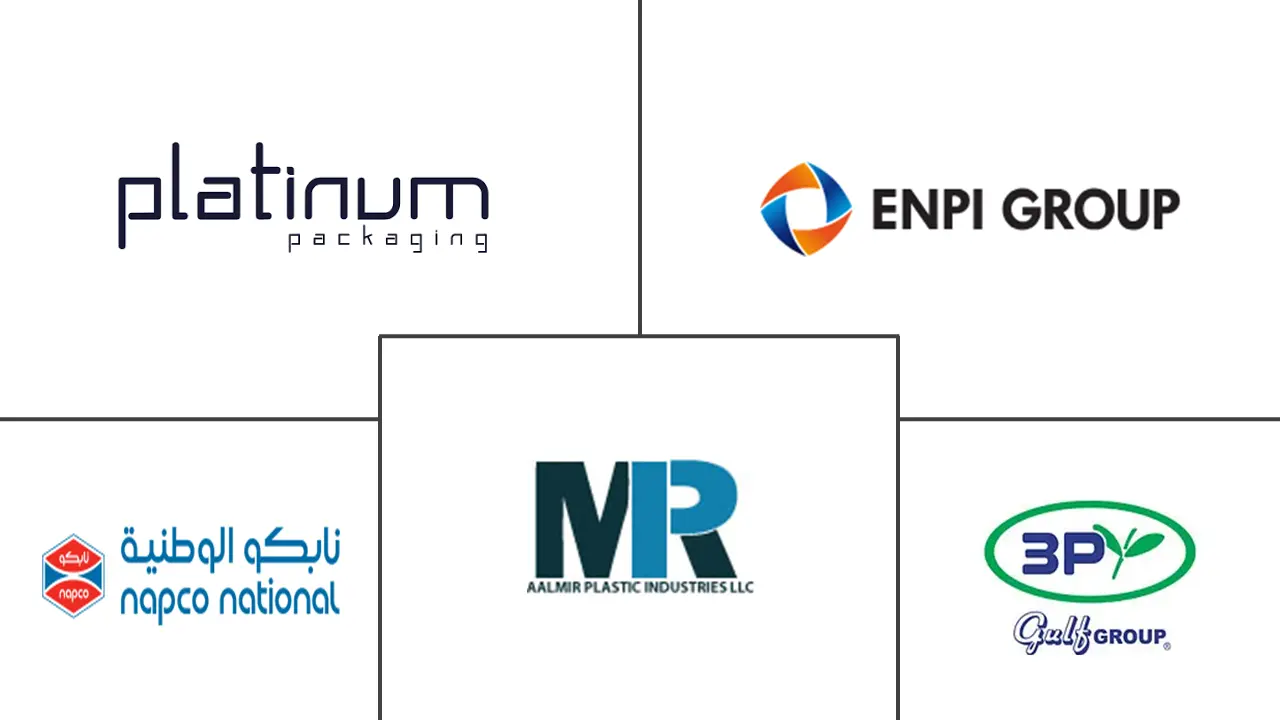
*Disclaimer: Major Players sorted in no particular order |
Middle East and Africa Flexible Packaging Market Analysis
The Middle East And Africa Flexible Packaging Market size in terms of production volume is expected to grow from 6.34 Million tonnes in 2024 to 7.68 Million tonnes by 2029, at a CAGR of 3.92% during the forecast period (2024-2029).
Flexible packaging allows more economical and customizable options for packaging products. It is particularly useful in industries requiring versatile packaging, including food and beverage, personal care, and pharmaceutical industries. Flexible packaging has grown popular due to its high efficiency and cost-effectiveness.
- The packaging business in the region has experienced consistent growth over the last decade due to changing consumer expectations and a rising population. Sustainability and environmental aspects might continue to be emphasized in the region as the market is witnessing various innovations in packaging materials. Increased demand for recyclable and sustainable packaging materials, such as paper and cardboard, recycled PET (rPET), and bioplastics, are driving market growth.
- Moreover, the changing consumer food preferences in the United Arab Emirates have created significant growth opportunities in the packaging industry, especially for the food and beverage industry. According to a report by Alpen Capital, a financial institute in the United Arab Emirates, the food industry in the Middle East and African region is estimated to grow due to its strategic location and growing population. Post-pandemic, the surge in online food delivery has enhanced the demand for flexible packaging such as wraps, sleeves, labels, and others, driving industry growth.
- Additionally, the increasing influence of Western eating habits among domestic consumers has boosted the demand for packaged foods. This trend is further supported by immigrants, tourists, and young consumers driving the demand for ready-to-eat, processed, and frozen foods.
- The lighter weight, reduced material use, and lower shipping cost of stand-up pouches than the rigid packaging benefit the packaged food producers. With the beverage industry increasingly consuming pouches in the region, the demand from the market is expected to increase.
- The Middle East faces significant challenges in the flexible packaging industry due to its limited recycling infrastructure. This issue has become increasingly prominent as sustainability concerns gain traction globally and within the region. Despite growing awareness of the environmental problems and implementing various government initiatives to promote recycling and waste reduction, the need for adequate recycling facilities and systems continues to pose a substantial obstacle. This situation creates a complex dynamic for flexible packaging manufacturers and users in the region as they strive to balance market demands with emerging sustainability requirements.
Middle East and Africa Flexible Packaging Market Trends
Food Industry to be the Largest End User
- The Middle East packaged food market is experiencing growth due to advancements in food processing techniques and changing consumer lifestyles. These factors are expected to increase product demand, driving the growth of flexible packaging during the forecast period.
- Further, the rising Middle Eastern population and a growing appetite for meat, seafood, and poultry fuel the demand for flexible plastic packaging. Innovations in packaging materials and designs also contribute to this trend, as manufacturers seek to meet consumer preferences for convenience and extended shelf life.
- In addition, the growth of e-commerce in Middle Eastern countries, such as the United Arab Emirates and Saudi Arabia, is driving demand for convenience food. This trend is reshaping the flexible packaging landscape, including films, wraps, pouches, and bags, which help maintain food freshness and warmth for extended periods.
- The food industry in the GCC region, a major chunk of Middle East and Africa, recovered after the pandemic. The growing population, coupled with the increasing number of working professionals and many expatriates, is a major driver for the region’s food industry. Growing awareness of healthy eating habits of consumers in the region seeking high nutritional value has led to rising demand for fresh and organic food items. The use of plastic bags and pouches for food packaging, as pouches are low in weight and strength, drives the demand for flexible plastic packaging.
- According to a report by Alpen Capital, food consumption in GCC countries is estimated to grow to 56.2 million metric tons in 2027, driven by the increase in per capita income and growing population. Saudi Arabia is estimated to be the largest country in the region in terms of food consumption, followed by the United Arab Emirates and Bahrain.
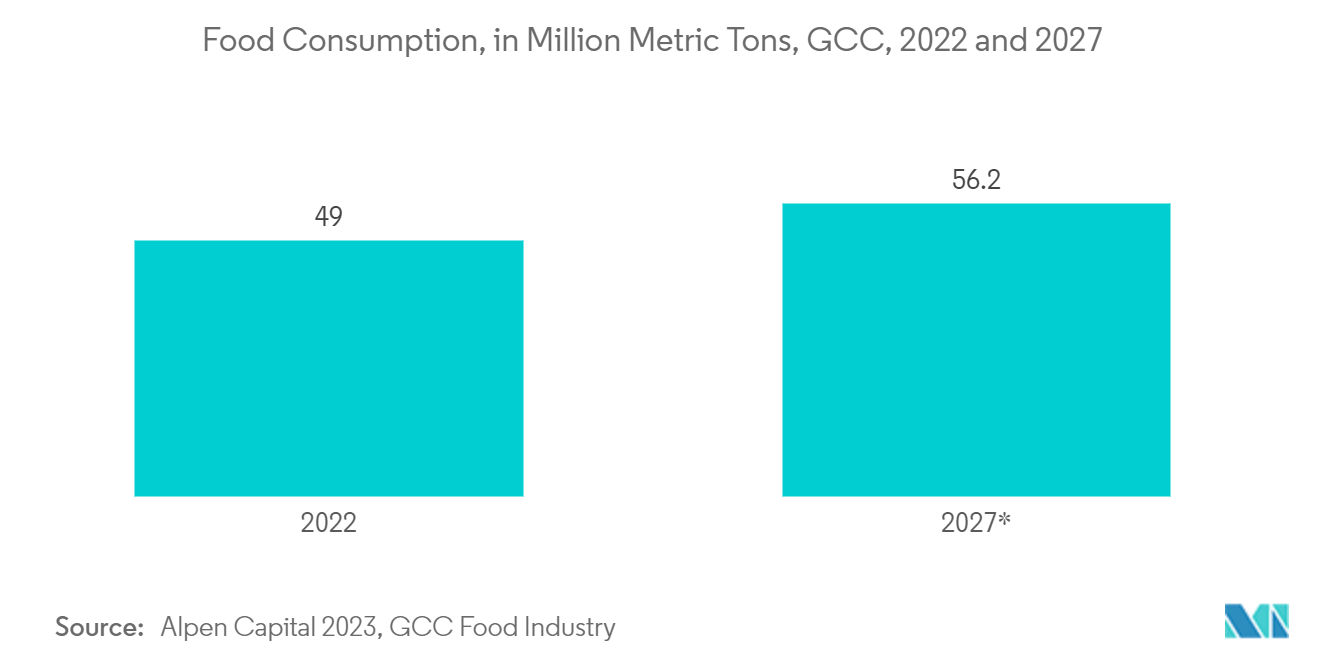
Saudi Arabia Holds Major Market Share
- Saudi Arabia's strategic location at the intersection of three continents positions it as a critical access point to markets in the Middle East, Africa, and Asia. The country's well-developed infrastructure, efficient transportation networks, and advanced logistics facilities provide significant advantages for global trade and investment opportunities.
- Saudi Arabia has positioned itself as an attractive destination for businesses seeking new opportunities and growth. The Kingdom's ambitious economic reforms, strategic initiatives, and evolving business landscape transform it into a potential global business center. This transformation has garnered increasing attention from packaging businesses worldwide, reflecting Saudi Arabia's growing importance in the international market.
- With the demand for flexible packaging solutions rising in sectors like food, retail, consumer goods, and pharmaceuticals, businesses are increasingly eyeing Saudi Arabia. The country's strategic positioning will make it a key player in shaping regional and international trade, investment, and innovation.
- The Ready-to-Eat Meals and Frozen Food segment offers prepared food that requires minimal or no preparation before consumption. This segment is gaining popularity in Middle Eastern countries, particularly in Saudi Arabia, due to the fast-paced urban lifestyle and diverse cultural influences.
- The Saudi Arabian market for processed meat, seafood, and meat alternatives is experiencing growth. In 2023, the market volume was approximately 1,499.10 metric tons. Projections indicate an increase to about 1,839.50 metric tons by 2027, reflecting the country's changing and growing consumer preferences for processed meat.
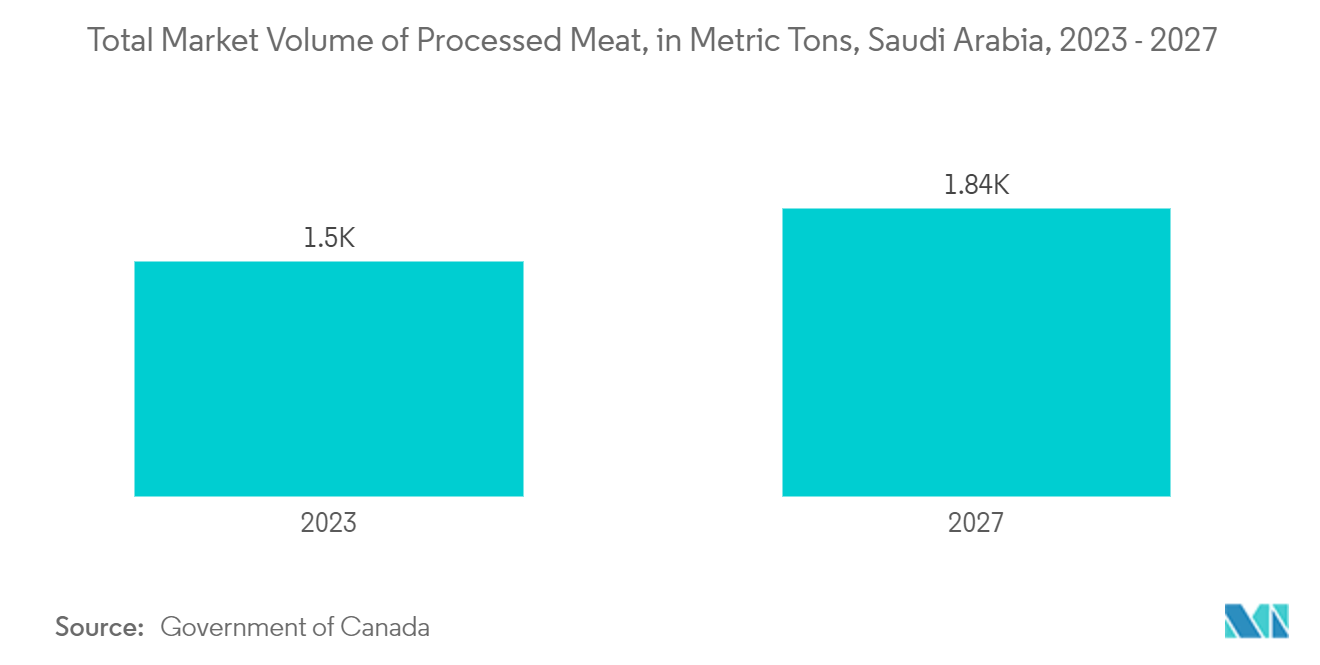
Middle East and Africa Flexible Packaging Industry Overview
The Middle East and Africa Flexible Packaging Market are fragmented, with multiple players in the market operating regionally. The degree of competition depends on various factors affecting the market, such as brand identity, powerful competitive strategy, degree of transparency, and firm concentration ratio. Some of the major players in the market are Napco National, 3P Gulf Group, Platinum Packaging Ltd, Aalmir Plastic Industries LLC, and ENPI Group, among others.
- June 2024 - Huhtamaki, a key player in sustainable packaging solutions, has revealed plans to consolidate its Flexible Packaging manufacturing operations in the United Arab Emirates (UAE). The strategy involves retaining its Jebel Ali facility while significantly enlarging its Ras Al Khaimah site. According to the company, this move aims to streamline operations, elevate competitiveness, and fortify its foothold for future regional expansion.
- May 2024 - Napco National expanded its packaging division by strategically acquiring Alsharq Plas LLC, a brand based in the United Arab Emirates. Post-acquisition, Alsharq Plas LLC will be rebranded as Napco Sharq Plas LLC. This move is poised to bolster both companies' capabilities in meeting the increasingly sophisticated demands of customers in the GCC region. Furthermore, the acquisition is expected to bolster Napco National's market presence.
Middle East and Africa Flexible Packaging Market Leaders
-
Napco National
-
3P Gulf Group
-
Platinum Packaging Ltd
-
ENPI Group
-
Aalmir Plastic Industries LLC
*Disclaimer: Major Players sorted in no particular order
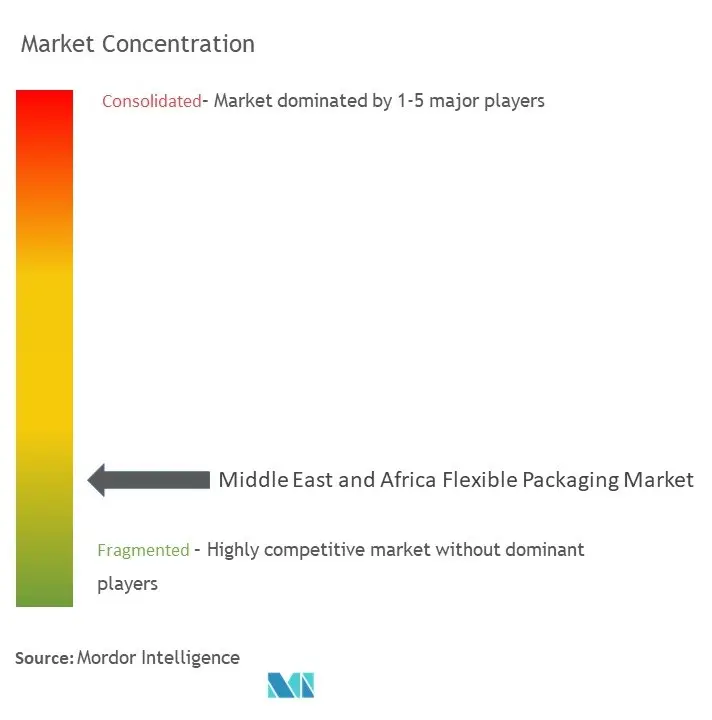
Middle East and Africa Flexible Packaging Market News
- April 2024: SABIC, a global player in the chemical industry, recently unveiled its circular packaging project in Saudi Arabia as part of its TRUCIRCLE program to promote a circular plastic economy. FONTE, a significant player in the Saudi Arabian bakery sector, introduced bread bags made from SABIC's certified circular polyethylene (PE) for their Oat Arabic Bread.
- January 2024: Napco National, a prominent player in petrochemical packaging, forged a strategic alliance with OQ and Madayn, pledging an investment between USD 15 million and USD 48 million. This initiative, centered on producing advanced plastic packaging films, directly supports Oman Vision 2040, which seeks to enhance the nation's economic competitiveness and diversity.
Middle East and Africa Flexible Packaging Market Report - Table of Contents
1. INTRODUCTION
- 1.1 Study Assumptions and Market Definition
- 1.2 Scope of the Study
2. RESEARCH METHODOLOGY
3. EXECUTIVE SUMMARY
4. MARKET INSIGHTS
- 4.1 Market Overview
- 4.2 Industry Ecosystem Analysis Suppliers, Material Manufacturers, etc.
-
4.3 Industry Attractiveness - Porter's Five Forces Analysis
- 4.3.1 Bargaining Power of Suppliers
- 4.3.2 Bargaining Power of Buyers
- 4.3.3 Threat of New Entrants
- 4.3.4 Intensity of Competitive Rivalry
- 4.3.5 Threat of Substitute Products
- 4.4 Import-Export Analysis
5. MARKET DYNAMICS
-
5.1 Market Drivers
- 5.1.1 Steady Rise in Demand for Processing Food
-
5.2 Market Restraints
- 5.2.1 High Raw Material Costs and Limited Recycling Infrastructure
-
5.3 Market Opportunities
- 5.3.1 Growing Demand for Sustainable Packaging Solution
6. MARKET SEGMENTATION
-
6.1 By Material Type
- 6.1.1 Plastics
- 6.1.1.1 Polyethene (PE)
- 6.1.1.2 Polypropylene (PP)
- 6.1.1.3 Polyethylene Terephthalate (PET )
- 6.1.1.4 Other Plastics (PVC, PA, etc.)
- 6.1.2 Paper
- 6.1.3 Aluminum
- 6.1.4 Compostable Materials (PLA, PBS, PHA, PBAT, etc.)
-
6.2 By Product Type
- 6.2.1 Pouches And Bags
- 6.2.2 Films And Wraps
- 6.2.2.1 Thermoforming Film
- 6.2.2.2 Stretch Films
- 6.2.2.3 Shrink Film
- 6.2.2.4 Cling Film
- 6.2.3 Labels And Sleeves
- 6.2.4 Lidding And Liners
- 6.2.5 Blister Packaging
-
6.3 By End-user Industry
- 6.3.1 Food
- 6.3.2 Beverages
- 6.3.3 Pharmaceuticals
- 6.3.4 Cosmetics And Personal Care
- 6.3.5 Household Care
- 6.3.6 Pet Care
- 6.3.7 Tobacco
- 6.3.8 Other End-user Industries (Electronics, Chemicals, Agricultural Products etc.)
-
6.4 By Country***
- 6.4.1 Saudi Arabia
- 6.4.2 United Arab Emirates
- 6.4.3 Morocco
- 6.4.4 Egypt
- 6.4.5 South Africa
7. COMPETITIVE LANDSCAPE
-
7.1 Company Profiles*
- 7.1.1 Napco National
- 7.1.2 3P Gulf Group
- 7.1.3 Platinum Packaging Ltd
- 7.1.4 Aalmir Plastic Industries LLC
- 7.1.5 ENPI Group
- 7.1.6 Amber Packaging Industries LLC
- 7.1.7 Emirates Printing Press (LLC)
- 7.1.8 Huhtamaki Flexibles UAE (Huhtamki Oyj)
- 7.1.9 Gulf East Paper and Plastic Industries LLC
- 7.1.10 Radiant Packaging Industry LLC
- 7.1.11 Arabian Flexible Packaging LLC
- 7.1.12 Integrated Plastics Packaging LLC
- 7.1.13 Constantia Flexibles Afripack (Constantia Flexibles)
- 7.1.14 SwissPac UAE
- 7.1.15 Hotpack Packaging Industries LLC
- 7.1.16 Falcon Pack
8. INVESTMENT OUTLOOK
9. FUTURE OUTLOOK OF THE MARKET
** Subject To AvailablityMiddle East and Africa Flexible Packaging Industry Segmentation
Flexible packaging refers to any package or portion of a package that can easily change its shape when filled or being utilized. Flexible packaging is made from combinations of paper, plastic, film, aluminum foil, or other materials and consists of bags, pouches, liners, wraps, roll stock, and other flexible items.
The Middle East and Africa flexible packaging market is segmented by material type (plastics (Polyethylene (PE), Polypropylene (PP), Polyethylene terephthalate (PET), other plastics (PVC, PA, etc.)), paper, aluminum, compostable materials (PLA, PBS, PHA, PBAT, etc.), product type (pouches, films and wraps [thermoforming film, stretch films, shrink film, cling film], labels and sleeves, lidding and liners, blister packaging), end-user verticals (food, beverages, pharmaceuticals, cosmetics and personal care, household care, pet care, tobacco, other end-user industries (electronics, chemicals, agricultural products, etc.)), and Country (Saudi Arabia, United Arab Emirates, Morocco, Egypt, South Africa, and the rest of the Middle East and Africa). The report offers market forecasts and size in volume (tonnes) for all the above segments.
| By Material Type | Plastics | Polyethene (PE) |
| Polypropylene (PP) | ||
| Polyethylene Terephthalate (PET ) | ||
| Other Plastics (PVC, PA, etc.) | ||
| By Material Type | Paper | |
| Aluminum | ||
| Compostable Materials (PLA, PBS, PHA, PBAT, etc.) | ||
| By Product Type | Pouches And Bags | |
| Films And Wraps | Thermoforming Film | |
| Stretch Films | ||
| Shrink Film | ||
| Cling Film | ||
| Labels And Sleeves | ||
| Lidding And Liners | ||
| Blister Packaging | ||
| By End-user Industry | Food | |
| Beverages | ||
| Pharmaceuticals | ||
| Cosmetics And Personal Care | ||
| Household Care | ||
| Pet Care | ||
| Tobacco | ||
| Other End-user Industries (Electronics, Chemicals, Agricultural Products etc.) | ||
| By Country*** | Saudi Arabia | |
| United Arab Emirates | ||
| Morocco | ||
| Egypt | ||
| South Africa |
Middle East and Africa Flexible Packaging Market Research FAQs
How big is the Middle East And Africa Flexible Packaging Market?
The Middle East And Africa Flexible Packaging Market size is expected to reach 6.34 million tonnes in 2024 and grow at a CAGR of 3.92% to reach 7.68 million tonnes by 2029.
What is the current Middle East And Africa Flexible Packaging Market size?
In 2024, the Middle East And Africa Flexible Packaging Market size is expected to reach 6.34 million tonnes.
Who are the key players in Middle East And Africa Flexible Packaging Market?
Napco National, 3P Gulf Group, Platinum Packaging Ltd, ENPI Group and Aalmir Plastic Industries LLC are the major companies operating in the Middle East And Africa Flexible Packaging Market.
What years does this Middle East And Africa Flexible Packaging Market cover, and what was the market size in 2023?
In 2023, the Middle East And Africa Flexible Packaging Market size was estimated at 6.09 million tonnes. The report covers the Middle East And Africa Flexible Packaging Market historical market size for years: 2019, 2020, 2021, 2022 and 2023. The report also forecasts the Middle East And Africa Flexible Packaging Market size for years: 2024, 2025, 2026, 2027, 2028 and 2029.
Middle East and Africa Flexible Packaging Industry Report
Statistics for the 2024 Middle East and Africa Flexible Packaging market share, size and revenue growth rate, created by Mordor Intelligence™ Industry Reports. Middle East and Africa Flexible Packaging analysis includes a market forecast outlook to 2029 and historical overview. Get a sample of this industry analysis as a free report PDF download.



